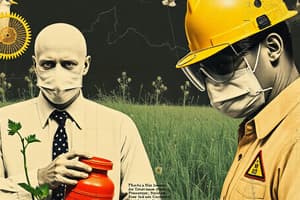Podcast
Questions and Answers
Why is participant segmentation considered important in education and training programs?
Why is participant segmentation considered important in education and training programs?
- It ensures compliance with international standards.
- It allows for easier facilitation by homogenizing participants. (correct)
- It provides a platform for diverse opinions and debates.
- It decreases the overall cost of training.
What is the primary goal of education and training programs in the context of pesticide use?
What is the primary goal of education and training programs in the context of pesticide use?
- To introduce new types of pesticides to the market.
- To ensure the safe and effective use of pesticide products. (correct)
- To develop a global network of pesticide distributors.
- To promote the sales of agrochemicals.
What is the potential disadvantage of relying solely on labels for communicating important information about pesticides?
What is the potential disadvantage of relying solely on labels for communicating important information about pesticides?
- Labels may lack flexibility and not adequately reach end-users with low literacy. (correct)
- Labels are unregulated and may provide inaccurate advice.
- Labels offer more detailed information than other sources.
- Labels are too costly to produce and update frequently.
In the context of farmers' meetings, what strategy helps build trust and rapport with participants?
In the context of farmers' meetings, what strategy helps build trust and rapport with participants?
Which principle of responsible product stewardship involves understanding how others impact risk in a products life cycle?
Which principle of responsible product stewardship involves understanding how others impact risk in a products life cycle?
What approach is most effective for training individuals on pesticide management and first aid for pesticide poisoning?
What approach is most effective for training individuals on pesticide management and first aid for pesticide poisoning?
What should organizations prioritize when designing educational programs involving posters?
What should organizations prioritize when designing educational programs involving posters?
What does the concept of 'Life Cycle Thinking' primarily aim to achieve in responsible product stewardship?
What does the concept of 'Life Cycle Thinking' primarily aim to achieve in responsible product stewardship?
Why might mass media be considered of limited value in the 'systemic transfer of knowledge' regarding responsible pesticide use?
Why might mass media be considered of limited value in the 'systemic transfer of knowledge' regarding responsible pesticide use?
What is the role of the Fertilizer and Pesticide Authority (FPA) regarding education in the Philippines?
What is the role of the Fertilizer and Pesticide Authority (FPA) regarding education in the Philippines?
What is the significance of conducting baseline surveys before implementing a stewardship project?
What is the significance of conducting baseline surveys before implementing a stewardship project?
What additional incentives could be provided to farmers to encourage their attendance and participation in agricultural meetings?
What additional incentives could be provided to farmers to encourage their attendance and participation in agricultural meetings?
What should be considered when offering invitations to medical health practitioners for training?
What should be considered when offering invitations to medical health practitioners for training?
What is the role of 'Supply Chain Communication' in ensuring responsible product management?
What is the role of 'Supply Chain Communication' in ensuring responsible product management?
What is the key distinction between 'education' and 'training' as defined in the context of agrochemical use?
What is the key distinction between 'education' and 'training' as defined in the context of agrochemical use?
How does emphasizing 'innovation' contribute to product stewardship?
How does emphasizing 'innovation' contribute to product stewardship?
When addressing stakeholders concerns about product safety, what long-term strategy should organizations prioritize?
When addressing stakeholders concerns about product safety, what long-term strategy should organizations prioritize?
What is the main challenge that agrochemical companies face when trying to educate pesticide users in developing countries?
What is the main challenge that agrochemical companies face when trying to educate pesticide users in developing countries?
What is the primary objective of the 'Integration' principle in responsible product stewardship?
What is the primary objective of the 'Integration' principle in responsible product stewardship?
Following a farmers meeting, what action can demonstrate respect for the participants culture on the part of the organizers?
Following a farmers meeting, what action can demonstrate respect for the participants culture on the part of the organizers?
Flashcards
Participant Segmentation
Participant Segmentation
Grouping people by interest, education, work, or economic status to facilitate training.
Education (Agrochemicals)
Education (Agrochemicals)
Transfer of information to encourage improved agricultural practices and safety.
Training (Agrochemicals)
Training (Agrochemicals)
Demonstration that aims to produce improved practices.
Show me and I remember
Show me and I remember
Signup and view all the flashcards
Involve me and I understand
Involve me and I understand
Signup and view all the flashcards
Inviting Farmers to Events
Inviting Farmers to Events
Signup and view all the flashcards
Prepare Farmers' Meeting
Prepare Farmers' Meeting
Signup and view all the flashcards
Facilitation Tip
Facilitation Tip
Signup and view all the flashcards
Offering Something
Offering Something
Signup and view all the flashcards
Shared Responsibility
Shared Responsibility
Signup and view all the flashcards
Life Cycle Thinking
Life Cycle Thinking
Signup and view all the flashcards
Knowlege
Knowlege
Signup and view all the flashcards
Supply Chain Communication
Supply Chain Communication
Signup and view all the flashcards
Stakeholders
Stakeholders
Signup and view all the flashcards
TeamWork
TeamWork
Signup and view all the flashcards
Study Notes
- Education and Training seeks to protect those in the pesticide industry and end-users, as well as the physical environment, from unwarranted pesticide exposure
- The challenge is effectively communicating how to avoid pesticide exposure
- The FAO has set guidelines in the international code of conduct on the distribution of pesticides for education and training
- Standards in agrochemical use must improve, especially in developing countries like the Philippines where many pesticide users are semi-literate
- Agrochemical companies should provide education and training to ensure safe and effective product use
- The Fertilizer and Pesticide Authority prioritizes Agro-Medical Training in education campaigns
Key Training Areas
- Safe and judicious use of pesticides
- Training barangay health workers in first aid for pesticide poisoning
- Safe storage at the farm level
- MOA-based resistance management
- Proper disposal of used pesticide containers
- The utility of safe lockboxes for transport and storage
Education Definition
- The transfer of information for improved practice
- Disseminating educational materials is essential for improved standards in agrochemical use
Training Definition
- The demonstration of improved practice
Participant Segmentation
- Grouping people by interest, education, work, or economic status
- The goal is to homogenize participants for easier facilitation in meetings or training
- Heterogeneous participants in meetings can lead to longer training times and effort
Cardinal Points on Learning Process
- Key principle: "Tell me and I forget, Show me and I remember, Involve me and I understand."
- "Tell me and I forget" involves giving lectures without visual aids, which results in low knowledge retention
- "Show me and I remember" entails lectures with visual aids that increase participant interest and knowledge retention
- "Involve me and I understand" refers to longer training and demonstrations of pesticide management and first aid, which is the most effective way to communicate
- A complete demonstration of crop growth and activities can be done during a field day called “Season Long Train in One Day”
Inviting Participants
- Send invitation cards to prospective farmers, potentially with the assistance of barangay officials
- Distributors/Dealers, coordinate with the Fertilizer and Pesticide Authority to ensure participation.
- Medical Health Practitioners can be invited to training at night due to patient schedules, involving municipal/provincial health officers
Conducting Farmers' Meetings
- Preparation: Analyze the audience, and align the meeting with their interests and resources.
- Ensure the meeting suits religious and cultural preferences, keeping the location politically, socially and religiously neutral
- Facilitation includes showing genuine interest in farmers' concerns and recognizing their knowledge
- Use visuals like flipcharts and understandable language, and do not push your own agenda
- Offer incentives like information, materials, or refreshments, as farmers often expect something for their time
Running the Meeting
- State and achieve a desired output, such as collecting information or teaching a technique
- Listen to farmers and show interest in their opinions and practices
- Highlight but do not push your own agenda
- Take breaks to keep people fresh
- Be conversational and build rapport with farmers
- Collect feedback to learn about concerns and improve extension efforts
- Encourage participation but avoid lecturing
- Respect farmers' views and avoid debates
- Build trust and accept offers to snack with farmers or visit their fields
- In measuring success and setting priorities, assess the project's impact on the community.
- Establish measurement parameters before implementing a project and conduct a baseline survey
- Use a third party research outfit to avoid bias
Sources of Information in Education
- Labels on product packs are important documents providing safety information and directions
- However, labels are limited by space and may not be effective for end-users with limited literacy
- Leaflets are attached to products or distributed separately to supplement label information
- Posters can support educational programs if well-designed and distributed
- Mass media (newspapers, radio, TV, internet) can create awareness and change attitudes
- Supporting education materials include video tapes, slides, flipcharts, and booklets, tailored to the target audience
Principles of Responsible Product Stewardship
- Shared Responsibility: Ensure safe management of products throughout their lifecycle
- Life Cycle Thinking: Prevent risks and increase sustainability throughout the product's life cycle
- Knowledge: Understand health, safety, and environmental risks
- Supply Chain Communication: Share necessary hazard information with relevant parties
- Stakeholders: Understand concerns and work together to manage safety
- Team work: Determine the what, where, why, and how of a product to find more sustainable solutions
- Awareness: Watch for new information relating to risks and safer products
- Innovation: Commitment to product stewardship stimulates innovation in reducing risks and improving value with new and better products and processes
- Management: Manage implement practices that will continually stewardship forward.
- Integration: Product stewardship should be integral to how a business operates and become common sense.
Studying That Suits You
Use AI to generate personalized quizzes and flashcards to suit your learning preferences.




